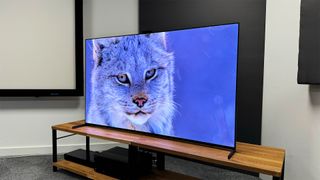
Screen size: 65in (also available in 55in, 77in)
Type: QD-OLED
HDR formats: HLG, HDR10, Dolby Vision
HDMI inputs: x 4 (2 x 48Gbps HDMI 2.1)
Dimensions (hwd, without stand): 83 x 144 x 3.4cm
The A95L is one of the most impressive TVs from last year. It has all the features you would expect, stunning picture quality and it's one of the best-sounding TVs you can buy – for an appreciable sonic improvement, you'll need more than a budget soundbar. But it is still pricey...
For
- Stunning brightness, contrast and colours
- But even-handed and authentic, too
- Crisp, direct and spacious sound
Against
- Still only two HDMI 2.1 sockets
- Some gaming features coming later
- No UK catch-up apps
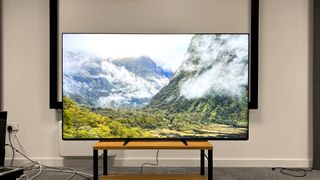
Screen size: 75in (also available in 85in, 65in in the US)
Type: QLED
HDR formats: HLG, HDR10, Dolby Vision HDR
HDMI inputs: x 4 (2x 48Gbps HDMI 2.1)
Dimensions (hwd, without stand): 96 x 167 x 4.8cm
On paper, the Bravia 9 has it all – immense brightness, more sonic grunt and extra features over and above the A95L. But a couple of picture bugs cost it dearly. If Sony can fix these – and we're sure it can – it could be the TV to beat. As it is, it's a solid though unremarkable four-star performer.
For
- Dazzling brightness and highlights
- Impressive height effects from built-in speakers
- Excellent local dimming on dark backgrounds
Against
- Buggy and compromised picture on some content
- Sound could be weightier
- User interface can be sluggish at times
Sony’s 2024 TV lineup looks a little different from the years gone by, not least in its naming convention. There are no Xs or As in this year’s TVs — instead the manufacturer has brought its Bravia branding front and centre, with the Bravia 9 this year’s flagship TV in a trio of newcomers.
It’s a Mini LED set, and is the successor to last year’s five-star X95L. However, unlike that set, it’s being officially positioned above the company’s flagship OLED, the A95L – another five-star set – which remains in the line up from last year. If you were wondering where Sony sat on the whole Mini LED vs OLED conversation, the Bravia 9 seems to answer it.
But how does it stack up against its biggest in-house rival? And if you’re looking to invest in a premium Sony TV this year, where should your money go? We’ve put them head to head based on our thorough reviews process – let's see which is right for you.
Sony Bravia 9 vs A95L: price and availability
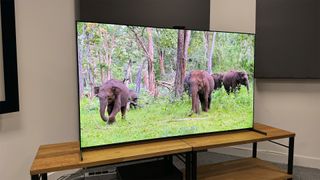
The Bravia 9 is a big TV with big aspirations. In the UK and Australia, it only comes in 75- and 85-inch sizes – the 65-incher is only available in the US at present. The A95L is more versatile, coming in 55- and 65-inch variants, but only goes up to 77 inches. Its launch price was higher than the Bravia 9 at its top size, and it seems to have stuck around there quite stubbornly. Roll on Black Friday!
** Winner: Sony Bravia 9 **
| Size | Bravia 9 | A95L |
|---|---|---|
| 55in | N/A | £2499 / $2799 / AU$5295 |
| 65in | £N/A / $3300 / AU$N/A | £3199 / $3299 / AU$5995 |
| 75in | £4499 / $4000 / AU$6495 | N/A |
| 77in | N/A | £5499 / $4999 / AU$9499 |
| 85in | £4999 / $5500 / AU$7495 | N/A |
Sony Bravia 9 vs A95L: design

Whether you choose the Bravia 9 or the A95L, you're going to be getting Sony's preference for straight and pointy design language. We've no arguments with that, both look smart, with slim bezels from the front and nicely flat back panels for wall mounting. Neither are gobsmackingly slim from their side profile, but to call them chunky would probably be a bit cheeky.
The feet on the Bravia 9, just like on the A95L, face forwards and sit at the edge of the set to avoid unwanted reflections. This can be troublesome when it comes to finding furniture wide enough – particularly at the larger screen sizes – so the Bravia 9 has the option to move them inwards towards the centre of the screen, which is welcome.
This wasn't an option on the A95L, except for the 77-inch screen size. Arguably that's the size that needs the feature the most, but we would have liked to have seen it on the 55- and 65-inch versions too.
While the Bravia 9 pips the A95L for convenience there, both TVs have the option to sit flush with your TV stand or to raise them up slightly, to accommodate a soundbar.
** Winner: Sony Bravia 9 **
Sony Bravia 9 vs A95L: features

Of course, the big difference between the two here is the TV technologies – the Bravia 9 is a Mini LED TV and the A95L is a QD-OLED. That makes the Bravia 9 the significantly brighter of the two.
Both TVs feature Sony's excellent Cognitive XR processor, though the Bravia 9 gets a slightly upgraded version this year that includes subtle improvements to things like Face Detection and Scene Recognition.
Elsewhere though, you can expect a lot of the same features between the two.
Both include many of Sony's other excellent picture processing improvements, which we've found to create a picture we have long praised as among the most subtle and insightful you'll find.
As always with Sony, both the Bravia 9 and the A95L supports HLG, HDR10 and Dolby Vision HDR formats, but there's no support for HDR10+. If we had to pick a side in the advanced HDR format argument, Sony falls on the right side of it, but it's still a shame to lose out on anything at these prices – Panasonic and Philips manage to include both in their TVs, after all.
The Bravia 9 does get an extra picture preset to play with, compared with the A95L, and that's the new Prime Video Calibrated Mode. A bit like the Netflix and Bravia Core (soon to be Sony Pictures Core) Calibrated Modes, it will automatically adapt itself to the content you're watching on Amazon's streaming service, to get it closer to the creator's intentions. If you're a big Prime Video fan, this may be an interesting feature to try out.
Both TVs use the Google TV smart platform, which offers a good selection of apps and a pretty strong recommendation engine, but for gamers, both TVs have their frustrations. There are only two HDMI 2.1 sockets for handling 4K/120Hz (including Dolby Vision gaming), VRR and ALLM – and one of those is eARC, so may be taken up by a soundbar or AV receiver.
It means neither one is better than the other if you have gaming in mind, but you can just about muddle through if you only own one console. Even better if that's a PS5 – both offer Sony's "Perfect for Playstation 5" automatic settings mode.
** Winner: Sony Bravia 9 **
Sony Bravia 9 vs A95L: picture
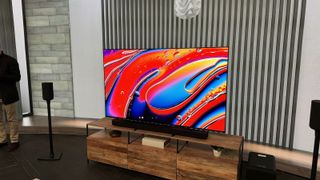
We've put the 75-inch Bravia 9 through its paces, and its picture is... a mixed bag. Expectations were high (thanks in no small part to Sony's bold claims), but there are a couple of niggles hold it back from scoring the full five stars. These are both software issues, so can hopefully be fixed with a future firmware upgrade, but we can't review the product that this might eventually become – we have to test what's in front of us, and what you, the consumer, would get for your money were you to buy it today.
And that's a TV with issues with both its both local dimming and its presets. The TV produces distracting jumps in brightness with local dimming activated. Turn off local dimming, and the picture becomes flat and dull. The presets are all heavily compromised too, each in their own way. Which makes it impossible to get the best out of it.
It's a shame, because when it's good it's really good. Bright highlights are exceptional, with detail even in the most eye-searingly glarey parts of the picture. That's something not even the LG G4 manages. Edges are strikingly sharp and well-defined, adding a real sense of depth to the picture, and while the black levels aren't quite OLED deep, they are impressive for a backlit TV. There's a distinct lack of haloing in areas of high contrast – not something we can say of the Samsung QN95D. Colours are well balanced, and skin tones – while a little pale – are very natural.
The Bravia 9 might be fussy like a diva, but also like a diva, that's doesn't detract from its talents, which are considerable and undeniable.
But while the Bravia 9 still feels like a work in progress, the A95L is the finished article. It took on the best in class in 2023 and convincingly beat the lot. We loved everything, from its contrast and colour handling to its accuracy, detail and insight. This has been a Sony strong point in its premium TVs for a while, but we have preferred – if pushed – the overall balance of of its OLEDs to its Mini LEDs. That's still true, for now at least...
** Winner: Sony A95L **
Sony Bravia 9 vs A95L: sound
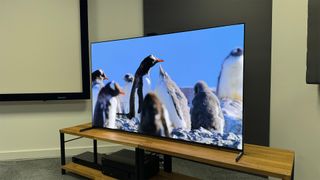
The Bravia 9 and the A95L use different methods to deliver sound, but are ultimately trying to give you the best sound quality you can muster from a TV without an additional soundbar.
The A95L uses the same Acoustic Surface Audio screen-shaking technology that we've seen in its OLEDs for a few years now. That is a 2.2-channel actuator-based sound system, with two actuators built behind the screen, vibrating it to produce sound. This is then backed up by two standard woofers to add some wallop to the low end.
It's a system we've long praised, and makes the A95L one of the best sounding TVs you can buy, thanks to great detail levels and a strong handling of dynamics. We reckon you couldn't easily best it with a budget soundbar, which is pretty impressive for a built-in system.
The Bravia 9, on the other hand, features a new iteration of Sony's Acoustic Multi Audio+. It's different to other versions since it features beam tweeters along the top of the frame, firing sound upwards, as well as frame tweeters on the sides giving the sound some width.
Sony claims this is an industry first, and helps to create a sound system with a 70W output. Not bad at all, and a little more powerful than the 60W offered by the A95L to boot.
In our testing, we found it similar in character to the X95L, but the new height speakers add space and the frame tweeters improve the directionality of the sound. This is very good indeed. Vocal clarity and low-level dynamics are also superb, while the levels of volume and projection possible are very good for a TV. The new Voice Zoom 3 dialogue-enhancing feature (which is coming to the A95L via a software update) does make speech clearer, and doesn't compromise the rest of the audio too much.
There's a lack of distortion at the low end, but also a slight lack of heft and impact. Sony's played it safe here – and that mostly works in its favour.
** Winner: Sony Bravia 9 **
Sony Bravia 9 vs A95L: verdict
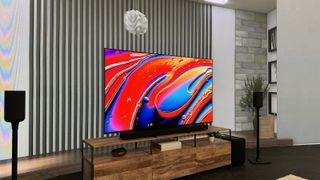
The Bravia 9 is a very impressive TV, packing in a backlight without bulking up too much. But a couple of irritating picture bugs prevent it from achieving true greatness. Hopefully Sony can iron these out with a firmware update, but given that picture quality is the most impactful element of a TV, we had to dock it a star.
Otherwise it's a great TV though, and particularly impressive on the sound front. It's just that the A95L is the better all-rounder, with great images and audio. It's the most impressive TV we saw last year (if money is no object). With prices sure to come down now it's getting on a bit, it could still prove to be the better buy even if Sony does fix the Bravia 9's picture niggles...
MORE:
Read our full Sony Bravia 9 review
And our Sony A95L review
Sony Bravia 9 vs Samsung QN95D: which is better?
